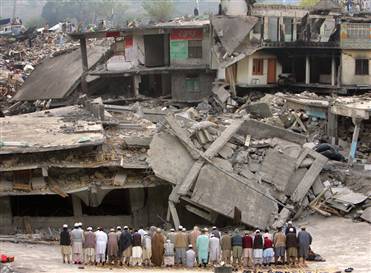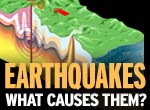
|
RESOURCE
GUIDE |
| MSNBC Home » Technology & Science » Science |
Quake's first seconds may show its strength
Study suggests early warning could be sent before brunt of quake hits
 |
Pakistani
men stand in prayer in front of a destroyed mosque in the town of Balakot,
one of several hard hit in last month's devastating South Asian
earthquake. |
|
Paula Bronstein / Getty Images file |
|
Most
Popular |
| |||||

The magnitude of an earthquake can be roughly predicted as the shaking begins, according to new research that promises to provide several seconds of warning before the brunt of a catastrophe strikes.
Earthquake prediction has proved tricky. Scientists can't pinpoint the timing of a rupture to within days or even months or years. But the new method provides an accurate glimpse of what will happen in just a moment.
"We can determine the magnitude within a couple of seconds of initiation of rupture and predict the ground motion from seconds to tens of seconds before it's felt," says Richard Allen, a seismologist at the University of California, Berkeley.
If an automatic warning system were set up, there might be time for school children to dive under desks and others to hunker down in doorways, Allen figures.
Waves come in
waves
The prediction is made possible by the fact that a typical
earthquake sends out three different types of waves, which Allen has been
studying for the past few years. He and colleague Erik Olson of the University
of Wisconsin-Madison examined the seismic records of 71 large temblors.
- Primary waves, or P waves, come first. They move like a pressure wave, typically creating a jolt. P waves are the least destructive.
- Next comes a secondary wave, or S wave. It shears the ground back and forth and up and down.
- Then come surface waves, the most destructive. They jerk the ground sideways and later roll in like ocean waves.
The frequency of P waves is related to the intensity of the eventual surface waves, Allen and his colleagues have determined.
The new results "imply that the final magnitude of an earthquake depends at least partially on what happens in its first few seconds," says Rachel Abercrombie, an expert in earthquake rupture at Boston University who was not involved in the study.
While no two earthquakes are alike, San Francisco would likely get 20 seconds or more of warning for a major temblor, Allen said.
"It is not a perfect system," Allen told LiveScience. But he added that all of the large-magnitude earthquakes his team has studied "do show this characteristic of the first few seconds" that allow a useful prediction. "The magnitude estimates in the study are within plus and minus 1 magnitude unit. For some events the error will be greater than others."
The science behind the idea is detailed in the Nov. 10 issue of the journal Nature.

|
MORE FROM
SCIENCE |
|
- © 2005 Microsoft
- MSN Privacy
- Legal
- Advertise






